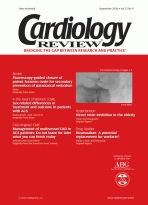Publication
Article
Cardiology Review® Online
Sexism and heart disease
Author(s):
While “sexism” has been a buzzword this year on the election trail, it has also been used in the field of medicine. Several investigators have reported differential treatment of men and women with heart disease. We now know that coronary artery disease (CAD) is a leading cause of death for women worldwide. In fact, each year more women than men die from cardiovascular disease, most from myocardial infarction and sudden death. Although awareness of the risk of heart disease among women has significantly increased, several recent studies suggest continued discrepancies in the management of CAD and acute coronary syndrome (ACS) between the sexes.
In this issue of Cardiology Review, Radovanovic and colleagues report that coronary interventions are used significantly less frequently in women presenting
with ACS. Similar findings have been reported by the GRACE (Global Registry of Acute Coronary Events) registry. These and other studies have also suggested that comorbidities, such as hypertension and diabetes, occur more frequently in women, which may partially explain the undertreatment of women. The paradoxical inverse relationship between higher risk and use of effective therapies is well documented but difficult to explain. Studies have also shown that women with ischemic heart disease are more likely than men to experience atypical symptoms and angina during rest, sleep, or mental stress. Women with CAD may also experience symptoms in locations other than the substernum, including the lower jaw and teeth, both arms, shoulders, back, and epigastric area. This presentation may contribute to misdiagnosis of CAD in women.
The National Heart, Lung, and Blood Institute recently started the Heart Truth program. This national awareness and prevention campaign stresses that heart disease is the #1 killer of American women, with 1 in 4 women succumbing to this disease. As clinicians, we should always consider heart disease as a diagnostic possibility in patients presenting with atypical symptoms, such as nonexertional chest discomfort or discomfort in locations beyond the chest. Cardiology Review recognizes the ramifications of heart disease in women and has dedicated a section called “In the Heart of Women” to educate clinicians on this topic.
An article in this issue by Schwartzman and Brenner addresses the controversial issue of non-culprit vessel angioplasty in patients with ACS, whereas the article by Meier is a testament to the rapid advances in health care technology. Meier reports how percutaneous closure of the patent foramen ovale can be accomplished in 15 minutes using fluoroscopy, eliminating the need for open heart surgery. Such technical advances continue to improve outcomes in patients with established heart disease, but they do not reduce the importance of determining strategies for disease prevention.
I would like to hear your thoughts on whether the issue of undertreatment of women is real, the potential reasons for this undertreatment, and how we can improve and optimize care for women with heart disease. You can send your thoughts on this topic to editor@cardiology-review.com. Comments will be published in an upcoming issue of Cardiology Review.






